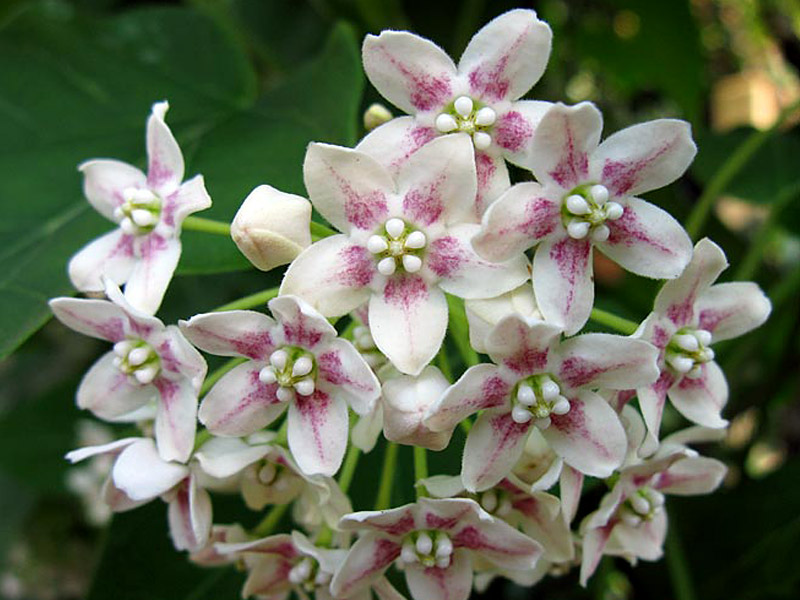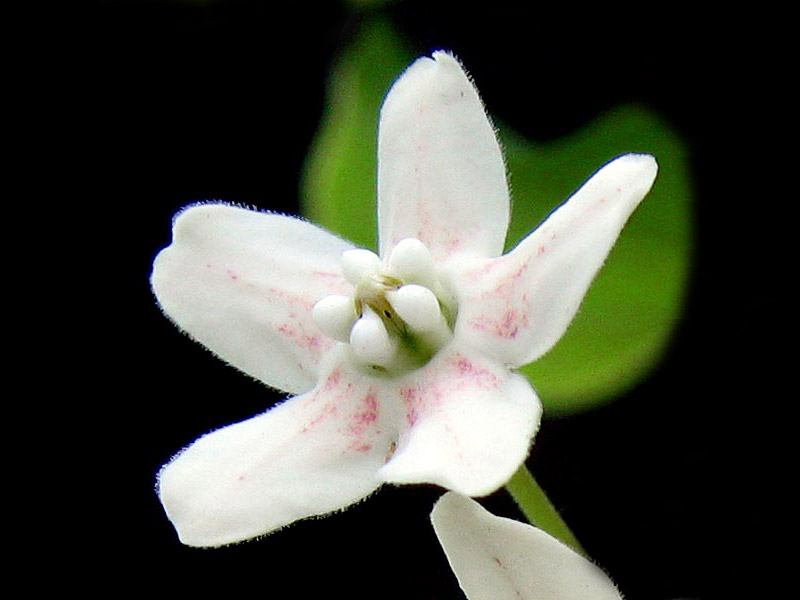It’s been a few days with colder weather here in London lately, and the forecast for the week-end is for frost – the first frost in London this winter. I decided I would start on one of the very few tasks in my garden I don’t really appreciate doing; pruning my Dregea sinensis.
Dregea sinensis is a climber; evergreen, semi-evergreen or deciduous, depending on climate and it grows very quickly once it is fully established. In London it will flower from May to September, but I have had flowers from April in warm springs and until late October in some years. It is strongly scented with a sweet and fruity scent which is most noticeable in the evening after a day with sunshine. Normally I prune my Dregeas late February, after a long spell of cold weather, but with the weather we have had lately, who knows when we next will get some cold weather! So I thought I better get started and use this cold snap while it lasts. Visitors who have been here on my blog throughout 2011 will probably remember that I have written about my Dregea sinensis before, ehh, quite a few times before actually, it, or they, because there are two plants…they have been a long running source of delight peppered with quite a lot of frustration. But I think me and my Dregeas have made peace now; we know each other well after almost 7 years together and I have made all the mistakes possible to make (hmm, best not tempt fate I can hear people whispering….), but really, Dregea didn’t turn out to be a very demanding plant after all, once we got to know each other.

There is only one exeption to that though, it requires pruning, unless you want it to cover a whole house, in which case you can just let it happily do its business! Well, maybe not a whole house, but I think it can grow to at least 10 feet, which is quite high! I have trained two plants over an arch dividing my garden in two, and that means it needs to look nice and tidy and I need to be able to pass through the arch without having to crouch down :-) Most plants aren’t that much of a job to prune, you just take a pair of secateurs and cut off what you don’t need….despite what some rose enthusiasts would like to make you believe, there really isn’t much more to it! But the trouble with the Dregea is that it has a white sticky sap which makes it virtually impossible to prune, except for when it is quite cold, the leaves have fallen off and the sap is not flowing that much. You see, although Dregea sinensis is an evergreen, it isn’t that in London; here it sheds its leaves in late December and starts producing new leaves straight away. They pop out as soon as the sun is warm enough, usually in early March. But in the countries where Dregea is normally growing, in tropical forests from South Africa to China, Dregea sinensis is an evergreen, and I have no idea what people do in terms of pruning there. Cut off or break off one branch and you have a dripping tap of white sticky sap that itches on your skin and is impossible to get out of your hair unless you wash it several times. The sap will also stain your clothes, paving slabs it drips onto and anything else which can’t be scrubbed clean with soap and water. Now think of that one dripping branch and multiply that with 100-200 and you can imagine what it would be like pruning the Dregea whilst it was full of spirit and life! Considering I have my two Dregeas over an arch and normally don’t stand on something when pruning, there is ample opportunities to get sprayed and dripped on for hours on end while working. But as I said, doing it in really cold weather, like today, makes the sap run a bit slower, and some of the smaller branches don’t even have sap running. But I still got dripped on, lots! My gardening coat looks terrible, and my face needed a wash halfway through because it was starting to itch. I have no idea what they do in the tropics in terms of pruning, or in countries where the winter temperature isn’t low enough to get the Dregea to shed its leaves. One of those environmental suits springs to mind, you know where you are covered from head to toe, and with a helmet….I wouldn’t mind having one myself! If anyone has a Dregea sinensis, in a tropical climate or on my side of the world, I would love to hear what you do to protect yourself when pruning :-)
And here is a little movie I have made with photos of the two Dregea sinensis growing up the arch; first the old arch I had which broke because the plants got too big and heavy (!!), and then on the new arch which is a bit sturdier and seems to hold better. As you will see, the plant grew quickly from two small cuttings in 2006 to cover the whole arch and becoming very big every autumn. This time I am pruning it harder than ever, leaving very little on the top. I hope I will get less leaves and more flowers by doing that. The flowers are very small, absolutely tiny! You don’t really get that impression through my macro lens, but they are no more than 12-15 mm, so the more flowers the better you see it from a distance.
You see, I really love this plant, I am not going to get rid of it, just because it gives me a bit of a fiddly job a couple of days per year! I love it so much that I have made cuttings and seedlings that I have given away, and there are several other people with babies from my plants in their garden. Incidentally, I got more seeds this year than I have had ever before, despite the rather dismal summer we have had. I have no use for the seeds though, so I guess they might go the same way as the seeds from last year, in the bin! If you are from the UK and would like to have some seeds, please go to my web-site (link on the left side), find the contact info page and send me an email. I will then get in touch with you directly. I must stress that this will be a first come first serve, as I have no idea how many will respond to this :-) If you live outside the UK, I am afraid I can’t help you, sending seeds abroad can be very difficult, with different rules for different countries, and unless sent from a licensed seller, the seeds might just be confiscated by custom. But I have seeds for about 15 people, and if you live close to East London and are tempted by what you have seen and heard so far, I am offering a few people to come and collect cuttings in July. Propagating from cuttings is much easier, and the plant will flower already the following year but will take 3-4 years to flower when grown from seeds. So send me an email and let me know if you are interested in either seeds or to come and pick up a few off-cuts to make cuttings. Alternatively, you can BUY the plant, at least here in the UK, but I haven’t seen it in the shops yet, only online via mail order. Use Google and you might find it for sale if you live in a different country too. I have heard an alternative name for it, Wattakaka sinensis, but I don’t think that’s used here in the UK anymore.
I didn’t finish the pruning today, I didn’t even get halfway finished, so that’s why I have called this post ‘Part 1’, as I intend to come back and show you the finished article! Not sure if that will be tomorrow, but we’ll see, I will take a photo for you when it’s done :-) Take care, see you soon!
I didn’t finish the pruning today, I didn’t even get halfway finished, so that’s why I have called this post ‘Part 1’, as I intend to come back and show you the finished article! Not sure if that will be tomorrow, but we’ll see, I will take a photo for you when it’s done :-) Take care, see you soon!


Excelent music to I love just love this .
ReplyDeleteWish could smell it Helene.:)
Helene, that is indeed a great plant. It looks so pretty growing on that arch in your garden. I also love the flowers, even though they might be small. Good luck with pruning part II!
ReplyDeleteChristina
Lovely video, wish I still lived int the UK as I would take some seeds to grow.
ReplyDeleteWhat a beautiful vine! Of course I googled right away, but here in the US there is non available, not even seeds *sigh* ... Love the detailed description :-)
ReplyDeleteI have a Confederate Jasmine vine, also with the milky sap. I put down painters cloth to protect the porch and wear old clothes and gloves, hair under handkerchief and sun glasses LOL I bet I look scary ;)
What beautiful flowers! I had never heard of it until reading your blog. I love vines, especially ones with fragrant flowers!
ReplyDeleteChristina: yes, it is pretty, and because none of my neighbours have it, it is even more precious to me – like a rare plant no-one has – well, almost no-one, but I have yet to meet anyone, in person or online, who has it in their garden!
ReplyDeleteCrafty Gardener: you live in Canada, right? Is it just as strict at the airports there as the USA border control? If not then perhaps you could get someone in your family here in the UK to email me and get some seeds. Next time someone visits you they could bring the seeds (providing anyone is visiting you the next 6 months or so). I don’t know the rules for bringing seeds from Europe to Canada, I know it is illegal between UK and USA, but it is perfectly legal within the European countries.
Gone Tropical: I have understood that Dregea sinensis is not a very common plant, but I find it strange that you can’t even get seeds for it in USA. Perhaps you can have more luck if you email a specialist nursery for tropical plants and ask them, use both names, Dregea sinensis and the previous name, now out of use, Wattakaka sinensis. Good luck! And your attire for pruning your Jasmine is quite similar to what I wear, I just need a few more layers as it is COLD here at the moment!
This comment has been removed by the author.
ReplyDelete